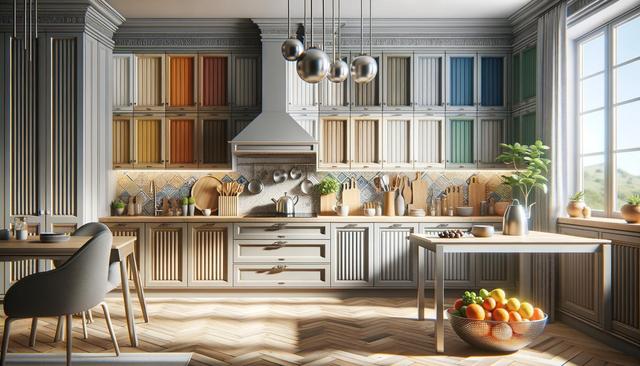Understanding the Role of Color in Kitchen Design
Color plays a significant role in the mood and functionality of a kitchen. The right kitchen cabinet colors can either brighten a space, make it feel larger, or bring a sense of warmth and coziness. Since cabinets take up a large portion of the visible area in a kitchen, their color choice greatly influences the overall aesthetic. Whether you are aiming for a modern, traditional, or transitional style, the cabinet color serves as the foundation of your design direction.
It’s also important to consider how your cabinet colors interact with the other elements in your kitchen, such as countertops, flooring, and wall paint. A cohesive color palette creates a harmonious environment, while clashing tones can make the space feel disjointed. Lighting—both natural and artificial—also affects how colors appear. A color that looks soft and muted in one space might appear bright and bold in another, depending on the light exposure.
Popular Cabinet Color Trends in Modern Kitchens
Over the past few years, kitchen cabinet color trends have shifted toward more personalized and expressive choices. While classic white remains a staple for its clean and timeless appeal, homeowners are increasingly turning to deeper and more diverse tones to add character and distinction to their kitchens. Some of the most popular options include:
- Soft grays for a neutral yet sophisticated look
- Rich navy and deep green for a bold, grounded presence
- Warm taupes and beiges that offer subtle earthiness
- Two-toned combinations for added visual interest
These color choices not only reflect current design preferences but also provide a long-lasting appeal that can withstand changing trends. The key is to choose shades that align with your personal style while considering how they will age over time. Neutral tones tend to have broader appeal, which can be beneficial if you plan to sell your home in the future.
Matching Cabinet Colors with Kitchen Layout and Size
The physical layout and dimensions of your kitchen should influence the cabinet color you choose. In smaller kitchens, lighter colors such as whites, creams, or pastels can help make the space feel more open and airy. Darker hues can work well in larger kitchens, where they bring depth and richness without overwhelming the space.
For kitchens with open layouts, it’s crucial to coordinate cabinet colors with adjacent living areas to maintain a seamless flow. Consider the following when planning your color palette:
- If your kitchen opens into a living room with warm tones, opt for similarly warm cabinet colors.
- Cool-toned living areas pair well with grays, blues, or greens in the kitchen.
- Natural wood finishes can act as a bridge between different color schemes.
Another factor to keep in mind is ceiling height. Darker cabinet colors can visually lower the ceiling, so they may not be ideal in spaces with limited vertical clearance. In contrast, light tones help create an illusion of height and openness.
Coordinating Cabinet Colors with Materials and Fixtures
When selecting kitchen cabinet colors, it’s essential to consider how they will coordinate with other materials such as countertops, backsplashes, and hardware. A well-thought-out color scheme ties all these elements together, creating a balanced and visually pleasing space. For example, white or light gray cabinets pair well with marble or quartz countertops, while darker cabinets complement butcher block or dark granite surfaces.
Hardware finishes also play a role in the overall aesthetic. Matte black handles can add a modern edge to lighter cabinets, while brass or bronze tones bring warmth to darker hues. Here are a few pairing suggestions to consider:
- White cabinets with brushed nickel or chrome hardware for a clean, contemporary look
- Gray cabinets with black hardware for a sleek industrial vibe
- Green or navy cabinets with gold hardware for a luxurious touch
By paying attention to these details, you can ensure that your kitchen feels cohesive and thoughtfully designed. Don’t forget to test color samples in your actual space before making a final decision—lighting and surrounding materials can significantly affect how a color appears.
Maintaining and Updating Cabinet Colors Over Time
Choosing the right cabinet color is just the beginning—maintenance and potential future updates are also part of the equation. Painted cabinets, for instance, may require occasional touch-ups, especially in high-traffic kitchens. Matte finishes can hide imperfections better than glossy ones, but they may also show grease or fingerprints more easily.
If you want flexibility for future updates, consider using neutral or classic colors as a base. These tones are easier to refresh with minor changes, such as swapping out hardware or adding a new backsplash. Here are a few maintenance tips to keep your cabinets looking fresh:
- Clean regularly with a mild soap solution to avoid buildup
- Use touch-up paint to fix small chips or scratches
- Avoid harsh chemicals that can damage the finish
In the long term, cabinet colors that are versatile and easy to maintain tend to offer better value. If you’re planning a DIY project, make sure to use high-quality paint or finishes designed specifically for cabinetry to ensure durability and a professional look.
Final Thoughts: Enhancing Your Kitchen with the Right Colors
Choosing the right kitchen cabinet colors is a decision that goes beyond trends. It’s about creating a space that reflects your personal style, complements your home’s layout, and stands the test of time. From calming neutrals to bold statement shades, the right color can elevate your entire kitchen experience. Take into account your overall design goals, the size and layout of your kitchen, and how different materials interact with your chosen color palette. With thoughtful planning, you can achieve a kitchen that feels both stylish and functional for years to come.




Leave a Reply